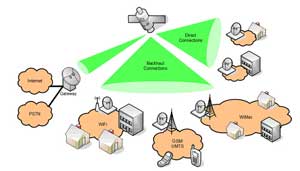April 2008 Edition
All Things Broadcasting Related
Features
Blockbuster Beaming,
Bringing the Internet To Remote Areas, by Dr. Axel Jahn
The Internet is a “Good Thing.” The Internet brings a huge range of benefits to people, businesses, and communities. The ever-increasing bandwidth available has extended the positive impact of the Internet, with the addition of more and more applications.

Executive Spotlights
Executive Spotlight On... Mary Frost, CEO—GlobeCast America
Executive Spotlight On... Stefan Jucken, Business Development & Marketing Americas—ND Satcom
Insight
INSIGHT: Broadcasting’s Brave New World, by Tara Giunta
Attention and interest in “broadcasting” services has also evolved from traditional, over-the-air, mass media programming to specialized, user-selected programming that covers multiple networks. In our multimedia future (where voice, video and data are delivered on all-digital networks), competition will increase and regulatory structures and policy challenges will certainly intensify. So much so, in fact, that the traditional regulatory classifications for broadcasting versus telecommunications services have already blurred, and will continue to do so.
INSIGHT... Prepare for the Indian Media Invasion, by Chris Forrester
INSIGHT... Going Beyond Sat Pay-TV Platforms... Video Demands It!, by Pacôme Revillon, Managing Director, Euroconsult
While DTH pay-TV platforms represent a key market for satellite operators, a large part of demand for video distribution is also driven by other applications.
INSIGHT... What Market Slowdown??, plus, How We See It...
Despite a precarious funding environment that, as widely reported, is not expected to improve in the near term, our view from the trenches is that the rapid evolution of new media and the technologies and infrastructure that support it have in no way slowed.
DVB-S2 + MPEG-4 in Satellite Delivered Applications..., The Need To Look Beyond Efficiency in Service Offerings
The History of Satellites — West Ford, by Donald Martin, Paul Anderson, Lucy Bartamian
The West Ford concept [1–4] grew out of a 1958 summer study on secure, hard, reliable communications.
Uplink
UPLINK: Maximizing Satellite Transmission Efficiency, Maximizing Satellite Transmission Efficiency With DVB-S2
Cost-effective transmission of high quality content is one of the primary business challenges facing broadcasters and system operators today. Using traditional standards, even premium subscription fees cannot possibly support HDTV’s high bandwidth requirements. New standards and technologies that maximize bandwidth usage efficiency are essential for profitability.

Focus
FOCUS... Advanced Workflow for SNG Via ScheduALL, by Rob Evans, Sr. Product Architect, ScheduALL
Satellite news gathering (SNG) technology has made impressive gains in the past decade, enabling broadcasters to deliver live, breaking news from remote and often extremely harsh locations.
Regular Departments
Editor's Notes,
The cross pollination between the satcom industry and the content delivery environs continues to increase, substantially. Approximately 60 percent of the editorial news and information we receive for SatMagazine and SatNews daily is also on topic for our new publication, digiGO! The Digital World.

